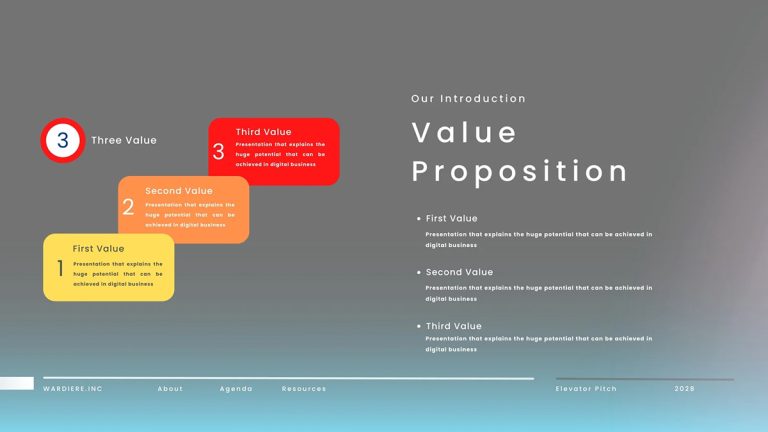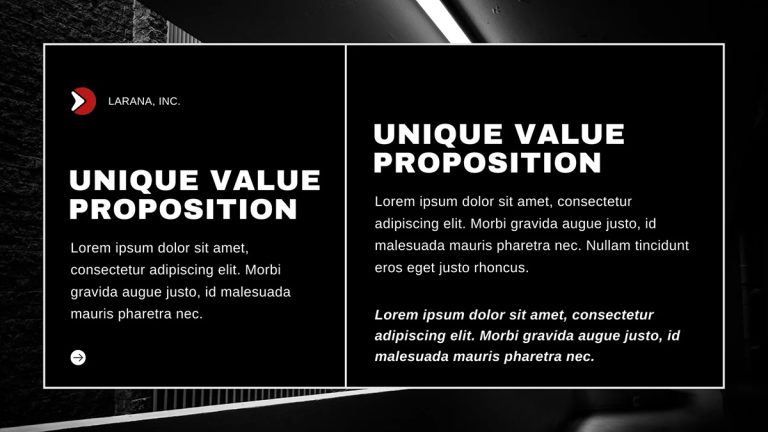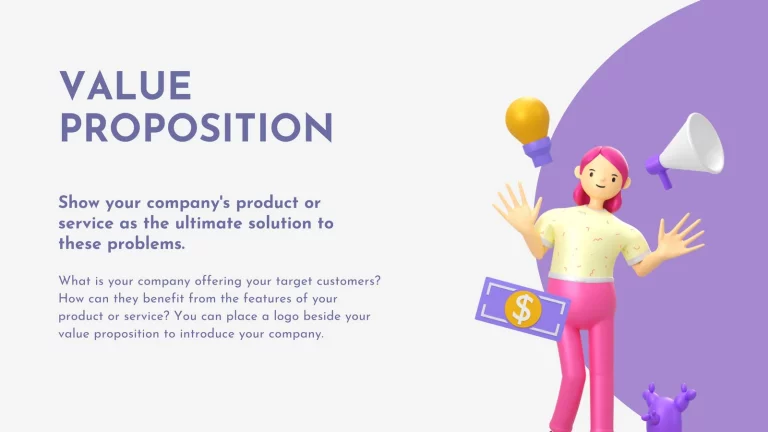How to Write an Effective Value Proposition: Examples and Tactics
You need a value proposition to introduce your company to the target customers. This online proposal showcases your offer and explains what makes your product or services special.

In this article, we'll explain what a value proposition is, how to write one and give you examples and tips to publish it online.
What is a value proposition?
A value proposition is a clear and brief document that explains what a company can offer its customers. It describes your products and services, shows the key benefits that help potential customers solve their problems, and clearly explains why they should choose your company over the competition.
Key points
-
A value proposition is a clear statement of the benefits a company offers its customers by addressing their needs and concerns.
-
The key elements of a good value proposition are clarity, specificity, differentiation, proficiency, and credibility.
-
Value propositions can, and should, be used in various marketing materials and strategies.
Understanding value proposition
The value proposition is a promise you make to your customers, ensuring them that you have the tools and solutions they need. Since it's a key part of many marketing efforts, it's important to understand what a value proposition is and what it isn’t.
The value proposition is:
-
A clear statement of benefits: It tells potential customers what they will gain by choosing your product or service and what benefits they will receive.
-
Problem-solving: It addresses a specific need or problem your customers are facing and may offer new solutions or quality-of-life improvements.
-
Making a difference: It distinguishes your company from the competition by highlighting unique features or advantages. Compare yourself to the leaders and show what only you offer.
The value proposition isn't:
-
Product description: While you should introduce the product, it is most important to show its key benefits.
-
Slogan or catchphrase: While slogans are catchy, value propositions are more detailed and informative. They must actually show what sets you apart.
-
Mission statement: A mission statement focuses on your company's overall goals, while a value proposition is more customer-focused.
How to write a value proposition
Before creating a value proposition, take care of marketing consistency by focusing on a single, clear idea of how to showcase your product's benefits to your target audience. Below are six key steps to help you create an effective value proposition:
1. Identify the customer’s main problems
2. Understand your target audience
3. Understand your competitors
4. List the benefits your product or service provides
5. Differentiate yourself as the preferred provider
6. Use a template to help you brainstorm
1. Identify the customer's main problems
You need to understand both your customers and your offer, and match them to their needs. For example, if you're selling cooling fans for laptops, you are addressing a specific need.
Imagine that your typical customer is a laptop producer who looks for a high-quality solution to provide cooling at an affordable cost. Tailor the solution towards your target customers and their needs.
2. Understand your target audience
Research their preferences, challenges, and behaviors. Once you identify their problems, you can tailor solutions accordingly. For instance, ensuring your fans are quiet and efficient.
If you can provide this solution in your value proposition, that's great! But if your current offering doesn’t meet their needs, consider alternative solutions or rebrand your product for a different group.
3. Understand your competitors
Read every review of your competition on platforms like Google, Yelp, and similar websites. What are their strengths and weaknesses? How can you match their good points, avoid their mistakes, and use your own unique features to improve the product quality?
4. List the benefits your product or service provides
Clearly state the value your product offers. This is not exactly a sales pitch, but it should serve as the foundation for a successful sales offer. Explain why each benefit matters and how you can adress them to specific customer issues.
5. Differentiate yourself as the preferred provider
Highlight your unique selling points and describe how you can overcome the market leader. If you can't, find another way you could promote your product and develop a list of strengths you can use to your advantage.
6. Use a template to help you brainstorm
There are many value proposition templates available online. Use these tools to organize your ideas and ensure clarity. Fill in the blanks to structure your thoughts.
You can then present your value proposition in a document for potential customers to learn about your products. Publish it using Publuu’s online flipbooks to make it accessible and professional.
Publuu’s online proposal example
View more examples
MAKE YOUR OWN
Key components of a value proposition
A strong value proposition typically consists of the following elements:
- A clear and memorable headline. Summarize your value proposition as a concise statement that directly communicates the main benefit to the customer. You can include some catchy slogans to make it easier for the customer to remember, but this shouldn't overshadow your value proposition statement.
- Supporting subtitle. This is an additional line giving additional details about the product or service, highlighting key features or benefits. While the main headline grabs attention, your subtitle should explain what you mean by that.
- Visual elements. Images, graphics, or other visual aids can improve understanding and engagement. They help communicate the value proposition more effectively. Use infographics and animations to create a unique document.
- Customer-facing product descriptions. In a value proposition, you should introduce your services or products. Describe their value by presenting facts based on market research and match them to customers' needs and preferences.
- Copy that reaches your target group. Describe how your product or service solves the customer’s problem. Storytelling is a great idea for this purpose – put the customer in the shoes of someone facing the problem, and tell the story of how your product provides the solution.
💡 Related topic: How to write a convincing brand story
What makes a good value proposition
A compelling value proposition is more than just a catchy slogan. It's a precisely targeted message that clearly communicates the benefits your product or service offers and hits the mark for your target audience.
Here are the key elements that make an effective value proposition:
Clarity
A clear value proposition addresses the customer's core need, avoiding misunderstanding or ambiguity. Don't say, “Our software allows you to edit videos and graphics” because this might be too broad. Instead, prepare two value propositions: one targeting graphic designers and another for video makers.
Your message should be simple and easy to understand without ambiguity or the use of industry jargon. People who know the industry already understand these terms, so you can use professional language in specific product or service descriptions.
Specificity
In your value proposition, clearly state the specific results customers can expect from your product or service. “Creating templates even 50% faster” or "Reducing work time by 10%" are good examples of specific ideas that are easy to understand and apply.
People are visual learners. Use examples, diagrams, or case studies to illustrate how your solution will solve their problems. Publuu flipbooks let you integrate photos, infographics, and even animations with your value proposition document to showcase specific benefits to your target customers.
CREATE YOUR VALUE PROPOSITION HERE!
Differentiation
Highlight the features that differentiate your product or service from the competition. Remember, you will always have competition, and your value proposition needs to answer the question: Why should the customer choose you over any other similar product?
Tailor your value proposition to meet the specific needs and desires of your target audience. Think about what needs your product addresses and why it's important to emphasize those issues in your stroytelling.
Proficiency
Demonstrate that you have the capabilities and resources to deliver on the promises you make in your value proposition. Show your experience and capabilities. Remember, you need to solve problems, not promise hundreds of new solutions that might not be fulfilled.
A great value proposition shows also that you have solved such problems in the past - provide product proof or technical capabilities with images of your factory, for instance. Promising too much or too little can hurt your brand - especially if you try to impress others with something that might not work.
Proficiency also means ensuring that your value proposition complies with all relevant laws and regulations. Enclose certificates and logos, and add pictures of any awards - these confirm your capabilities.
Credibility and trustworthiness
A strong value proposition must be backed by credibility and trustworthiness. You can achieve this through social proof: testimonials, reviews, and case studies from satisfied customers can greatly enhance your credibility. Similarly, any awards, certifications, or affiliations with well-known organizations or celebrities will also be valuable.
Tactics to create an effective value proposition
These crucial strategies will help you create a unique value proposition that highlights the benefits of your product or service to potential customers.
1. Benefit-focused approach
Focus on the benefits of your product's features, not the features themselves. Use this simple formula:
We help (X) do (Y) by doing (Z).
For example:
-
We help graphic designers design illustrations by providing faster access to key tools.
-
We teach English online using a flipped classroom strategy.
-
We provide board game fans with the best products, ensuring the best delivery on the market.
This method effectively connects your target market's needs to your solution.
2. Detailed framework
This strategy provides a more detailed framework, identifying industry categories alongside customer benefits:
For [target customer] who [needs or wants X], our [product/service] is a [industry category] that [benefit].
For example:
- For baristas who want top-tier coffee machines, our product offers fast brewing and intuitive operation.
This approach creates a clear and comprehensive value proposition.
3. Question-based method
Harvard Business School recommends answering these key questions to develop a strong value proposition:
-
What does my brand offer?
-
What task does the customer hire my brand to do?
-
Who are my competitors in this space?
-
What makes my brand unique?
These answers form the foundation of your value proposition.
4. Slow storytelling approach
This increasingly popular method, introduced in a 2022 article in the Journal of Business Research, was designed for the post-COVID digital era. It includes eight steps:
-
Introducing the organization
-
Defining the audience
-
Explaining the product story
-
Mapping the user journey
-
Highlighting sustainability
-
Engaging consumers
-
Turning customers into advocates
-
Enriching the overall experience
This method focuses on storytelling, explaining the meaning of products, presenting unique value sets, and demonstrating social impact.
5. Customer-centered approach
This strategy focuses on a deep understanding of your customers. Base the value proposition on market research, surveys, and interviews. Identify pain points, desires, and needs to tailor your value proposition accordingly.
For example, you may find that your product will be very popular with newcomers, and you can tailor your product and value proposition to this target group, focusing on a specific audience segment.
6. A/B testing
Create multiple versions of your value proposition and test them with your target group. You can create two propositions, one for professionals and one for novices. Use feedback and performance metrics to continually refine and optimize your message. Publuu lets you store, duplicate, and display various value proposition documents - making it easy to compare how many people read them all.
💡 Read more: Tracking document with Publuu
Value proposition templates
1. Grey simple proposal presentation
This clean and professional template is perfect for presenting a value proposition and clearly outlines your product's benefits with a structured design.
2. Black and white modern business value proposition
A minimalist black-and-white template, ideal for presenting your value proposition with a modern design that keeps the focus on your key message.
3. Purple illustrated value proposition template
This stylish purple and cream template it a great choice for tech companies to highlight their value proposition in a creative, illustrated format.
4. Purple modern 3D illustation value proposition
Featuring bold 3D illustrations, this template is ideal for presenting a value proposition that stands out with a modern and dynamic approach.
5. Green simple education value proposition
A simple yet effective green template, perfect for educational institutions to communicate their value proposition in a clear and professional way.
6. Modern logistic service value proposition
This modern template, tailored for logistics companies, presents their value proposition in visually appealing way and is optimized for eye-catching Instagram posts.
Value proposition example
Let's take a look at one of the most famous companies in the world - Apple. Here are the values that Apple follows and emphasizes in its marketing and search for new talent:
-
Integrated hardware and software: Apple's strength lies in designing and developing hardware and software that work seamlessly together to create a consistent user experience. Unlike Microsoft OS, which works with any PC manufacturer, Apple is a closed system, and macOS works only with Apple computers.
-
Innovation: Apple constantly introduces cutting-edge products and features. Each year, there's some new innovation, and the company's competitive advantage grows.
-
Quality: Their products are known for their excellent build quality and performance. Apple products "just work"!
-
Ease of use: Apple products are designed to be intuitive and easy to use. Their target market is casual users and artists.
-
Style: Their products often set trends in design and aesthetics. The modern smartphone experience was essentially created by Apple.
Apple's value proposition and core competencies complement each other perfectly. The company's focus on integrated hardware and software allows it to deliver innovative products. Apple's ability to deliver excellent products justifies the high prices it offers!
Lesson learned
Other companies can learn valuable lessons from Apple's approach:
-
Focus on main points: Identify your company's unique strengths and develop them. In Apple's case, it's integrated hardware and software, and they build their value proposition on this.
-
Do your research: Apple tests and has valuable knowledge of its offerings and competitors.
-
Invest in research and development: You must constantly stay ahead of the competition and innovate products. Apple's commitment to innovation has been a key factor in its success.
-
Build a strong brand: A strong brand helps you command a higher price and attract loyal customers. The Apple brand is easily recognizable everywhere in the world.
💡 Related topic: How to build a strong brand loyalty
FAQs about value propositions
Can I use my value proposition in my marketing materials?
Yes, your value proposition is a valuable tool for your marketing efforts. It can be used on your website, in social media posts, advertising campaigns, and other marketing materials.
Is there a specific form of value proposition?
No, a value proposition is not a specific type of document. You can create a value prop as part of your marketing strategy, include it in your business plan, or develop it as a positioning statement for addressing new or future customers. You can also use Publuu flipbooks to save a value proposition document for future reference, share it with customers or coworkers, or integrate it into your brand strategy.
How often should I review and update my value proposition?
You should review and update your value proposition regularly, especially if there are changes in your product, market, or competition. This ensures that your value proposition remains relevant and effective.
Conclusion
Creating a compelling value proposition is essential for attracting and converting potential customers. We hope that our comprehensive guide to key elements of value proposition, tips for creating and optimizing a value prop, will help you identify your core values and how to translate them into specific offer for your customer.
By following the steps outlined here and using tools such as Publuu for online publishing, you can create a powerful value proposition that effectively showcases the unique benefits of your product or service.
You may be also interested in:
How to Write an Executive Summary in 8 Easy Steps
How To Write a Business Proposal? 8 Steps with Tips





